Informal Urban Green Space: Residents’ Perception, Use, and Management Preferences across Four Major Japanese Shrinking Cities
Abstract
1. Introduction
2. Materials and Methods
2.1. Study Sites
2.2. Data Collection, Survey Instrument and Data Analysis
3. Results
3.1. Sample Characteristics
3.2. Respondents’ Perception, Use, and Evaluation of IGS
3.3. Respondents’ Preferences for IGS Management: Goals, Approaches, Willingness to Participate
3.4. Multiple Correspondence Analysis of Key IGS and Demographic Variables
4. Discussion
4.1. Perception, Evaluation, and Use of IGS
4.2. Preferred Management Goals
4.3. Preferred Management Approaches
4.4. Willingness to Volunteer
4.5. Main Contributions of This Study to Our Understanding of IGS
4.6. Limitations
5. Conclusions
- IGS is an integral part of the everyday urban landscape and residents’ daily lives. As such, planners should consider ways to integrate it into existing green plans.
- IGS has a wide variety of potential benefits and problems, but whether IGS affects residents’ positively or negatively depends on how it is managed. Current (non-)management produces positive outcomes for some residents, but remains suboptimal.
- Residents strongly support recreation, urban agriculture and conservation as three central functions and goals for IGS management. These preferences should form the basis of IGS management planning.
- Residents strongly support recreation, urban agriculture and returning space to nature as overarching uses for space opened up through urban shrinkage. These preferences question current efforts of national, regional and local governments to attract new residents and halt or even reverse urban shrinkage. Instead, residents’ preferences should form the basis for larger strategic urban planning.
- The city administration is expected to play a role in managing IGS, even in participatory planning arrangements. Participatory management should not lead to a complete retreat of government involvement in managing IGS, but actively draw on the local knowledge of residents.
- Realizing the potential of IGS for recreation likely requires a clear framework of rules around IGS use, mechanisms of consent to improve accessibility, and strategies to ameliorate liability issues. These three requirements indicate an important role to play for planners and green space managers.
- Participatory IGS management is expected to improve the urban landscape aesthetic. To achieve this outcome, residents require both financial and non-financial support from the city administration.
- A small but significant minority (~10%) of residents is willing to participate through offering time, skills and donations. As IGS only requires limited management to be evaluated considerably higher by residents, the basis of participatory IGS management likely exists. Participation should be voluntary, not forced.
Supplementary Materials
Acknowledgments
Conflicts of Interest
References
- Keniger, L.; Gaston, K.; Irvine, K.; Fuller, R. What are the Benefits of Interacting with Nature? Int. J. Environ. Res. Public Health 2013, 10, 913–935. [Google Scholar] [CrossRef] [PubMed]
- Lee, A.C.K.; Maheswaran, R. The health benefits of urban green spaces: A review of the evidence. J. Public Health 2011, 33, 212–222. [Google Scholar] [CrossRef] [PubMed]
- Bratman, G.N.; Daily, G.C.; Levy, B.J.; Gross, J.J. The benefits of nature experience: Improved affect and cognition. Landsc. Urban Plan. 2015, 138, 41–50. [Google Scholar] [CrossRef]
- Tzoulas, K.; Korpela, K.; Venn, S.; Yli-Pelkonen, V.; Kaźmierczak, A.; Niemela, J.; James, P. Promoting ecosystem and human health in urban areas using Green Infrastructure: A literature review. Landsc. Urban Plan. 2007, 81, 167–178. [Google Scholar] [CrossRef]
- Van den Berg, M.; Wendel-Vos, W.; van Poppel, M.; Kemper, H.; van Mechelen, W.; Maas, J. Health Benefits of Green Spaces in the Living Environment: A Systematic Review of Epidemiological Studies. Urban For. Urban Green. 2015, 14, 806–816. [Google Scholar] [CrossRef]
- Naumann, S.; Davis, M.; Kaphengst, T.; Pieterse, M.; Rayment, M. Design, Implementation and Cost Elements of Green Infrastructure Projects; Ecologic Institute and GHK Consulting: Berlin, Germany, 2010. [Google Scholar]
- Yokohari, M.; Bolthouse, J. Planning for the slow lane: The need to restore working greenspaces in maturing contexts. Landsc. Urban Plan. 2011, 100, 421–424. [Google Scholar] [CrossRef]
- Kobayashi, R.; Sakai, A. Study on transition of regenerating for city park in Sapporo city. J. City Plan. Inst. Jpn. 2008, 43.3, 583–588. [Google Scholar] [CrossRef]
- 2014 Status of Urban Green Space per Capita on Prefectural Basis. Available online: http://www.webcitation.org/query?url=https%3A%2F%2Fwww.mlit.go.jp%2Fcrd%2Fpark%2Fjoho%2Fdatabase%2Ft_kouen%2Fpdf%2F04_h26.pdf&date=2017-08-24 (accessed on 24 August 2017).
- Eanes, F.; Ventura, S.J. Inventorying Land Availability and Suitability for Community Gardens in Madison, Wisconsin. Cities Environ. CATE 2015, 8, 2. [Google Scholar]
- Savino, S.D.M. Facilitating Social-Ecological Transformation of a Vacant Lot on an Urban Campus: The Houston-Congolese Connection. Cities Environ. CATE 2015, 8, 4. [Google Scholar]
- Delgado, C. Answer to the Portuguese Crisis: Turning Vacant Land into Urban Agriculture. Cities Environ. CATE 2015, 8, 5. [Google Scholar]
- Dennis, M.; James, P. User participation in urban green commons: Exploring the links between access, voluntarism, biodiversity and well being. Urban For. Urban Green. 2016, 15, 22–31. [Google Scholar] [CrossRef]
- Gasperi, D.; Pennisi, G.; Rizzati, N.; Magrefi, F.; Bazzocchi, G.; Mezzacapo, U.; Centrone Stefani, M.; Sanyé-Mengual, E.; Orsini, F.; Gianquinto, G. Towards Regenerated and Productive Vacant Areas through Urban Horticulture: Lessons from Bologna, Italy. Sustainability 2016, 8, 1347. [Google Scholar] [CrossRef]
- Sugita, S.; Doi, Y. A Fundamental Study on Stewardship of Public Space by Local Community Groups. J. City Plan. Inst. Jpn. 2012, 47, 469–474. [Google Scholar] [CrossRef]
- IPSS Regional Population Projections for Japan: 2010–2040 (March 2013). Available online: http://www.ipss.go.jp/pp-shicyoson/e/shicyoson13/t-page.asp (accessed on 19 April 2016).
- Japanese Ministry of Land, Infrastructure and Transport. Toshi Kōenhō Unyō Shishin (dai 2 ban) (In Japanese; Urban Park Law Operation Guidelines, 2nd Edition). 2012. Available online: https://www.mlit.go.jp/crd/townscape/pdf/koen-shishin01.pdf (accessed on 24 August 2017).
- Yamada, C.; Terada, T.; Tanaka, T.; Yokohari, M. Directions for Vacant Lot Management in the Outer Suburbs of the Tokyo Metropolitan Region. Urban Reg. Plan. Rev. 2016, 3, 66–84. [Google Scholar] [CrossRef]
- Takano, T.; Nakamura, K.; Watanabe, M. Urban residential environments and senior citizens’ longevity in megacity areas: The importance of walkable green spaces. J. Epidemiol. Community Health 2002, 56, 913–918. [Google Scholar] [CrossRef] [PubMed]
- Gill, S.E.; Handley, J.F.; Ennos, A.R.; Pauleit, S. Adapting cities for climate change: The role of the green infrastructure. Built Environ. 2007, 33, 115–133. [Google Scholar] [CrossRef]
- Byrne, J.; Ambrey, C.; Portanger, C.; Lo, A.; Matthews, T.; Baker, D.; Davison, A. Could urban greening mitigate suburban thermal inequity?: The role of residents’ dispositions and household practices. Environ. Res. Lett. 2016, 11, 95014. [Google Scholar] [CrossRef]
- Kusaka, H.; Hara, M.; Takane, Y. Urban Climate Projection by the WRF Model at 3-km Horizontal Grid Increment: Dynamical Downscaling and Predicting Heat Stress in the 2070’s August for Tokyo, Osaka, and Nagoya Metropolises. J. Meteorol. Soc. Jpn. Ser. II 2012, 90, 47–63. [Google Scholar] [CrossRef]
- Rupprecht, C.D.D.; Byrne, J.A.; Ueda, H.; Lo, A.Y.H. “It”s real, not fake like a park’: Residents’ perception and use of informal urban green-space in Brisbane, Australia and Sapporo, Japan. Landsc. Urban Plan. 2015, 143, 205–218. [Google Scholar] [CrossRef]
- Rupprecht, C.D.D.; Byrne, J.A. Informal urban green-space: Comparison of quantity and characteristics in Brisbane, Australia and Sapporo, Japan. PLoS ONE 2014, 9, e99784. [Google Scholar] [CrossRef] [PubMed]
- Rupprecht, C.D.D.; Byrne, J.A.; Lo, A.Y.H. Memories of vacant lots: How and why residents used informal urban greenspace as children and teenagers in Brisbane, Australia and Sapporo, Japan. Child. Geogr. 2016, 14, 340–355. [Google Scholar] [CrossRef]
- Flint, C.G.; Kunze, I.; Muhar, A.; Yoshida, Y.; Penker, M. Exploring empirical typologies of human–nature relationships and linkages to the ecosystem services concept. Landsc. Urban Plan. 2013, 120, 208–217. [Google Scholar] [CrossRef]
- Jorgensen, A.; Keenan, R. (Eds.) Urban Wildscapes; Routledge: Abingdon, UK, 2012; ISBN 978-0-415-58106-6. [Google Scholar]
- Campo, D. The Accidental Playground; Fordham University Press: New York, NY, USA, 2013. [Google Scholar]
- Rupprecht, C.D.D.; Byrne, J.A. Informal urban greenspace: A typology and trilingual systematic review of its role for urban residents and trends in the literature. Urban For. Urban Green. 2014, 13, 597–611. [Google Scholar] [CrossRef]
- Informal Urban Greenspace Perception and Use: Survey Instrument. Available online: https://doi.org:10.13140/RG.2.1.3830.7448 (accessed on 24 August 2017).
- Takase, Y.; Furuya, K.; Sakuraba, S. The Relationship between Citizens’ Willingness to Work for Participation in Green Space Conservation Activities and Attributes, Citizens’ Willingness to Work and Attitude toward Participation. J. Jpn. Inst. Landsc. Archit. 2015, 78, 619–624. [Google Scholar] [CrossRef]
- Field, A.; Miles, J.; Field, Z. Discovering Statistics Using R; SAGE: Newcastle upon Tyne, UK, 2012; ISBN 978-1-4462-5846-0. [Google Scholar]
- R Development Core Team R: A Language and Environment for Statistical Computing. 2017. Available online: http://www.r-project.org (accessed on 24 August 2017).
- Bryer, J.; Speerschneider, K.; Bryer, M.J. Package “Likert”. 2016. Available online: http://cran.pau.edu.tr/web/packages/likert/likert.pdf (accessed on 24 August 2017).
- Husson, F. Package “FactoMineR”. 2017. Available online: https://cran.r-project.org/web/packages/FactoMineR/FactoMineR.pdf (accessed on 24 August 2017).
- JASP Team. T. JASP (Version 0.8.1.1). 2017. Available online: https://jasp-stats.org/ (accessed on 24 August 2017).
- Jamovi Team. T. Jamovi (Version 0.7.5.7). 2017. Available online: https://www.jamovi.org (accessed on 24 August 2017).
- QGIS Development Team QGIS Geographic Information System; Open Source Geospatial Foundation. 2017. Available online: http://qgis.osgeo.org (accessed on 24 August 2017).
- Jorgensen, A.; Tylecote, M. Ambivalent landscapes—Wilderness in the urban interstices. Landsc. Res. 2007, 32, 443–462. [Google Scholar] [CrossRef]
- Buijs, A.E.; Elands, B.H.M.; Langers, F. No wilderness for immigrants: Cultural differences in images of nature and landscape preferences. Landsc. Urban Plan. 2009, 91, 113–123. [Google Scholar] [CrossRef]
- Konijnendijk, C. Between fascination and fear—The impacts of urban wilderness on human health and wellbeing. Socialmed. Tidskr. 2012, 89, 289–295. [Google Scholar]
- Mathey, J.; Rink, D. Urban Wastelands–A Chance for Biodiversity in Cities? Ecological Aspects, Social Perceptions andAcceptance of Wilderness by Residents. In Urban Biodiversity and Design; Müller, N., Werner, P., Kelcey, J.G., Eds.; Wiley-Blackwell: Oxford, UK, 2010; pp. 406–424. [Google Scholar]
- Rink, D.; Herbst, H. From wasteland to wilderness—Aspects of a new form of urban nature. In Applied Urban Ecology: A Global Framework; Richter, M., Weiland, U., Eds.; Wiley-Blackwell: Chichester, UK, 2011; pp. 82–92. [Google Scholar]
- Vicenzotti, V.; Trepl, L. City as Wilderness: The Wilderness Metaphor from Wilhelm Heinrich Riehl to Contemporary Urban Designers. Landsc. Res. 2009, 34, 379–396. [Google Scholar] [CrossRef]
- Jeans, D.N. Wilderness, Nature and Society: Contributions to the history of an environmental attitude. Aust. Geogr. Stud. 1983, 21, 170–182. [Google Scholar] [CrossRef]
- Head, L.; Muir, P. Suburban life and the boundaries of nature: Resilience and rupture in Australian backyard gardens. Trans. Inst. Br. Geogr. 2006, 31, 505–524. [Google Scholar] [CrossRef]
- Instone, L. Encountering Native Grasslands: Matters of Concern in an Urban Park. Aust. Humanit. Rev. 2010, 49, 91–117. [Google Scholar]
- Foster, J. Restoration of the Don Valley Brick Works: Whose Restoration? Whose Space? J. Urban Des. 2005, 10, 331–351. [Google Scholar] [CrossRef]
- Kowarik, I. Urban wilderness: Supply, demand, and access. Urban For. Urban Green. 2017. [Google Scholar] [CrossRef]
- Davis, M. Dead Cities: And Other Tales; New Press: New York, NY, USA, 2002. [Google Scholar]
- Kellert, S.R. Attitudes, Knowledge, and Behavior Toward Wildlife Among the Industrial Superpowers: United States, Japan, and Germany. J. Soc. Issues 1993, 49, 53–69. [Google Scholar] [CrossRef]
- Corbin, C.I. Vacancy and the Landscape: Cultural Context and Design Response. Landsc. J. 2003, 22, 12–24. [Google Scholar] [CrossRef]
- Franck, K.A.; Stevens, Q. (Eds.) Loose Space: Possibility and Diversity in Urban Life; Routledge: Abingdon, UK, 2007. [Google Scholar]
- Schneekloth, L. Unruly and Robust: An abandoned industrial river. In Loose Space: Possibility and Diversity in Urban Life; Franck, K.A., Stevens, Q., Eds.; Routledge: Abingdon, UK, 2007; pp. 253–270. [Google Scholar]
- Unt, A.-L.; Travlou, P.; Bell, S. Blank Space: Exploring the Sublime Qualities of Urban Wilderness at the Former Fishing Harbour in Tallinn, Estonia. Landsc. Res. 2013, 39, 267–286. [Google Scholar] [CrossRef]
- Wolch, J.R.; Byrne, J.; Newell, J.P. Urban green space, public health, and environmental justice: The challenge of making cities “just green enough”. Landsc. Urban Plan. 2014, 125, 234–244. [Google Scholar] [CrossRef]
- Cabinet Office Japan. Kokumin Seikatsu ni Kansuru Yoron Chōsa (In Japanese; Public Opinion Poll on the Public’s Everyday Life). Available online: http://survey.gov-online.go.jp/h26/h26-life/index.html (accessed on 19 June 2017).
- Guidelines for Discovery and Use of Land in Cases of Unclear Ownership. Available online: http://www.webcitation.org/query?url=http%3A%2F%2Fwww.mlit.go.jp%2Fcommon%2F001178691.pdf&date=2017-08-24 (accessed on 24 August 2017).
- Rahmann, H.; Jonas, M. Void Potential: Spatial Dynamics and Cultural Manifestations of Residual Spaces. In Terrain Vague: Interstices at the Edge of the Pale; Mariani, M., Barron, P., Eds.; Routledge: Abingdon, UK, 2013; pp. 89–104. [Google Scholar]
- Sorensen, A. Conflict, consensus or consent: Implications of Japanese land readjustment practice for developing countries. Habitat Int. 2000, 24, 51–73. [Google Scholar] [CrossRef]
- Funabiki, T. A Study on the Relations between Land Use Regulation and Public Compensation in the Methods of Green-space Acquisition and Enhancement System. Pap. Environ. Inf. Sci. 2009, 23, 13–18. [Google Scholar] [CrossRef]
- Rupprecht, C.D.D.; Byrne, J.A.; Garden, J.G.; Hero, J.-M. Informal urban green space: A trilingual systematic review of its role for biodiversity and trends in the literature. Urban For. Urban Green. 2015, 14, 883–908. [Google Scholar] [CrossRef]
- Bonthoux, S.; Brun, M.; di Pietro, F.; Greulich, S.; Bouché-Pillon, S. How can wastelands promote biodiversity in cities? A review. Landsc. Urban Plan. 2014, 132, 79–88. [Google Scholar] [CrossRef]
- Oswalt, P.; Overmeyer, K.; Misselwitz, P. Patterns of the Unplanned. In Pop Up City; Schwarz, T., Rugare, S., Eds.; Cleveland Urban Design Collaborative: Cleveland, OH, USA, 2009; pp. 5–18. [Google Scholar]
- Explosives. Dumping Refuse on Vacant Lots. Injury to Children. Travell v. Bannerman, 75 N.Y. Supp. 866. Yale Law J. 1902, 12, 47. [CrossRef]
- Arnstein, S.R. A Ladder Of Citizen Participation. J. Am. Inst. Plann. 1969, 35, 216–224. [Google Scholar] [CrossRef]
- Takase, Y.; Furuya, K. Issues in Promoting Participation in Open Space Conservation Activities and Priority Ranking of Solutions from University Students’ Perspectives. J. Jpn. Inst. Landsc. Archit. 2013, 76, 717–722. [Google Scholar] [CrossRef]
- Takase, Y.; Furuya, K.; Sakuraba, S. Promotion Process for Green Space Conservation Activity Participation from Residents’ Perspectives. J. Archit. Plan. Trans. AIJ 2014, 79, 2241–2249. [Google Scholar] [CrossRef]
- Takase, Y.; Furuya, K.; Sakuraba, S. Challenges to Promote Participation in Conservation Activities Based on differences of attitude between Citizens and Open space Conservation Activity Organizations. J. Jpn. Inst. Landsc. Archit. 2014, 77, 553–558. [Google Scholar] [CrossRef]
- Takase, Y.; Furuya, K. Study on promoting public participation in green space conservation activities run by local governments. J. City Plan. Inst. Jpn. 2016, 51, 1016–1023. [Google Scholar] [CrossRef]
- Qviström, M. Taming the wild: Gyllin’s Garden and the urbanization of a wildscape. In Urban Wildscapes; Jorgensen, A., Keenan, R., Eds.; Routledge: Abingdon, UK, 2012; pp. 187–200. [Google Scholar]
- Sorensen, A. Centralization, urban planning governance, and citizen participation in Japan. In Cities, Autonomy, and Decentralization in Japan; Hein, C., Pelletier, P., Eds.; Routledge: Abingdon, UK, 2006; pp. 101–127. [Google Scholar]
- DelSesto, M. Cities, Gardening, and Urban Citizenship: Transforming Vacant Acres into Community Resources. Cities Environ. CATE 2015, 8, 3. [Google Scholar]
- Rosol, M. Grassroots Gardening Initiatives: Community Gardens in Berlin. In Enterprising Communities: Grassroots Sustainability Innovations; Robertson, D.P., Ed.; Emerald Group Publishing Limited: Bingley, UK, 2012; pp. 123–143. [Google Scholar]
- Chan, J.; DuBois, B.; Tidball, K.G. Refuges of local resilience: Community gardens in post-Sandy New York City. Urban For. Urban Green. 2015, 14, 625–635. [Google Scholar] [CrossRef]
- Rupprecht, C.D.D.; Byrne, J.A. Informal urban green space as anti-gentrification strategy? In Just Green Enough: Urban Development and Environmental Gentrification; Routledge Equity, Justice and the Sustainable City; Curran, W., Hamilton, T., Eds.; Routledge: London, UK, 2017. [Google Scholar]
- Curran, W.; Hamilton, T. Just green enough: Contesting environmental gentrification in Greenpoint, Brooklyn. Local Environ. 2012, 17, 1027–1042. [Google Scholar] [CrossRef]
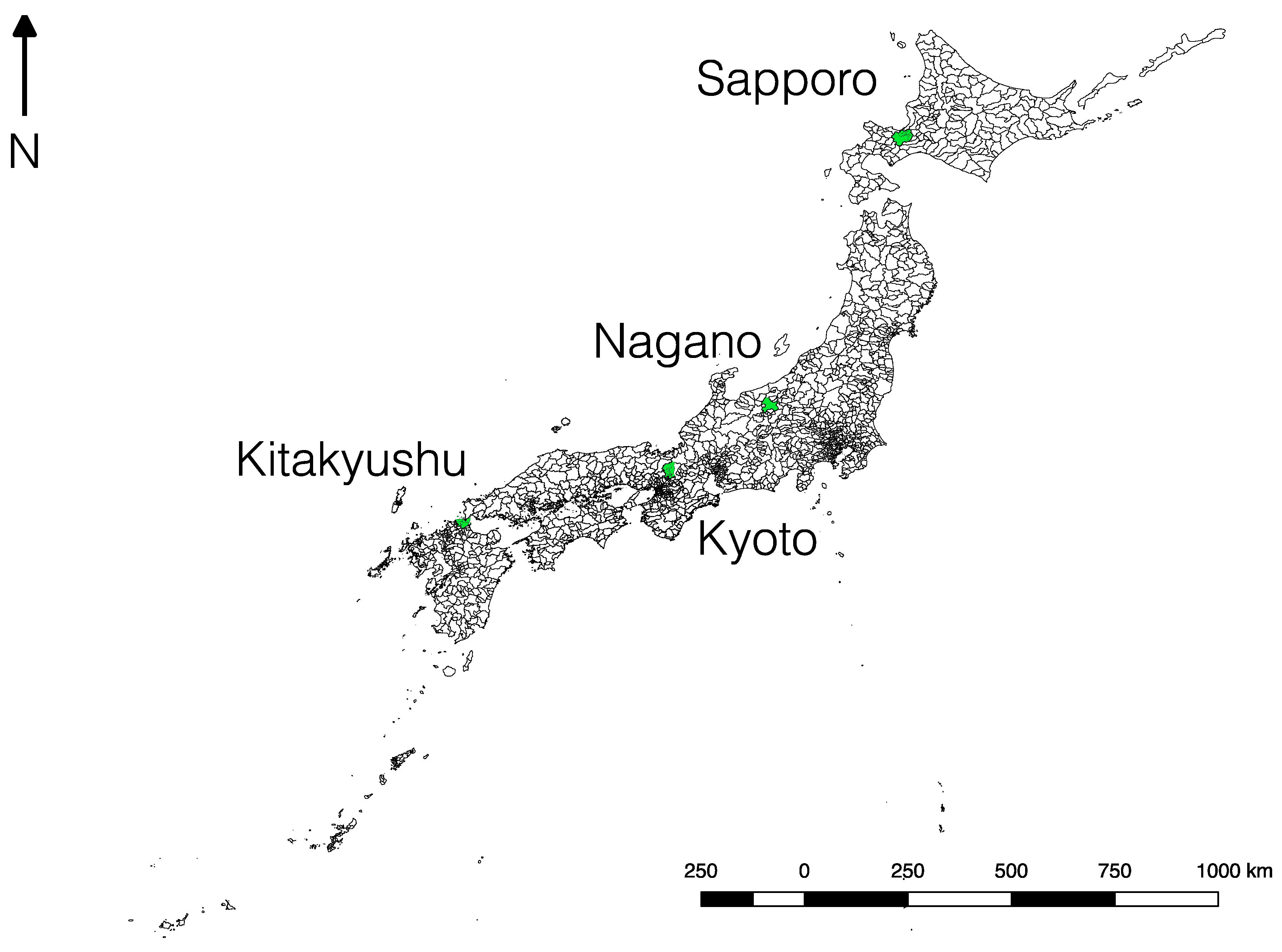
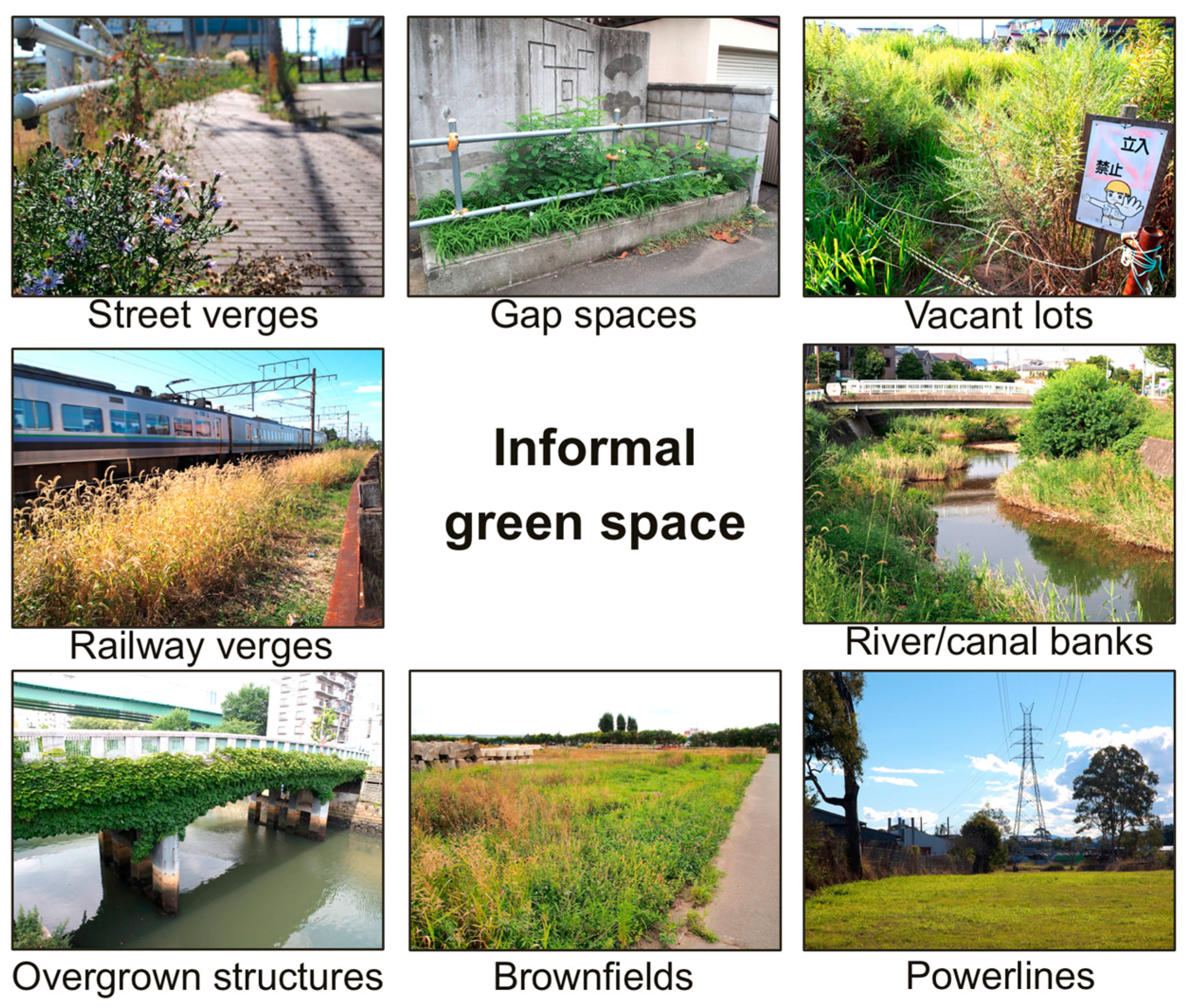
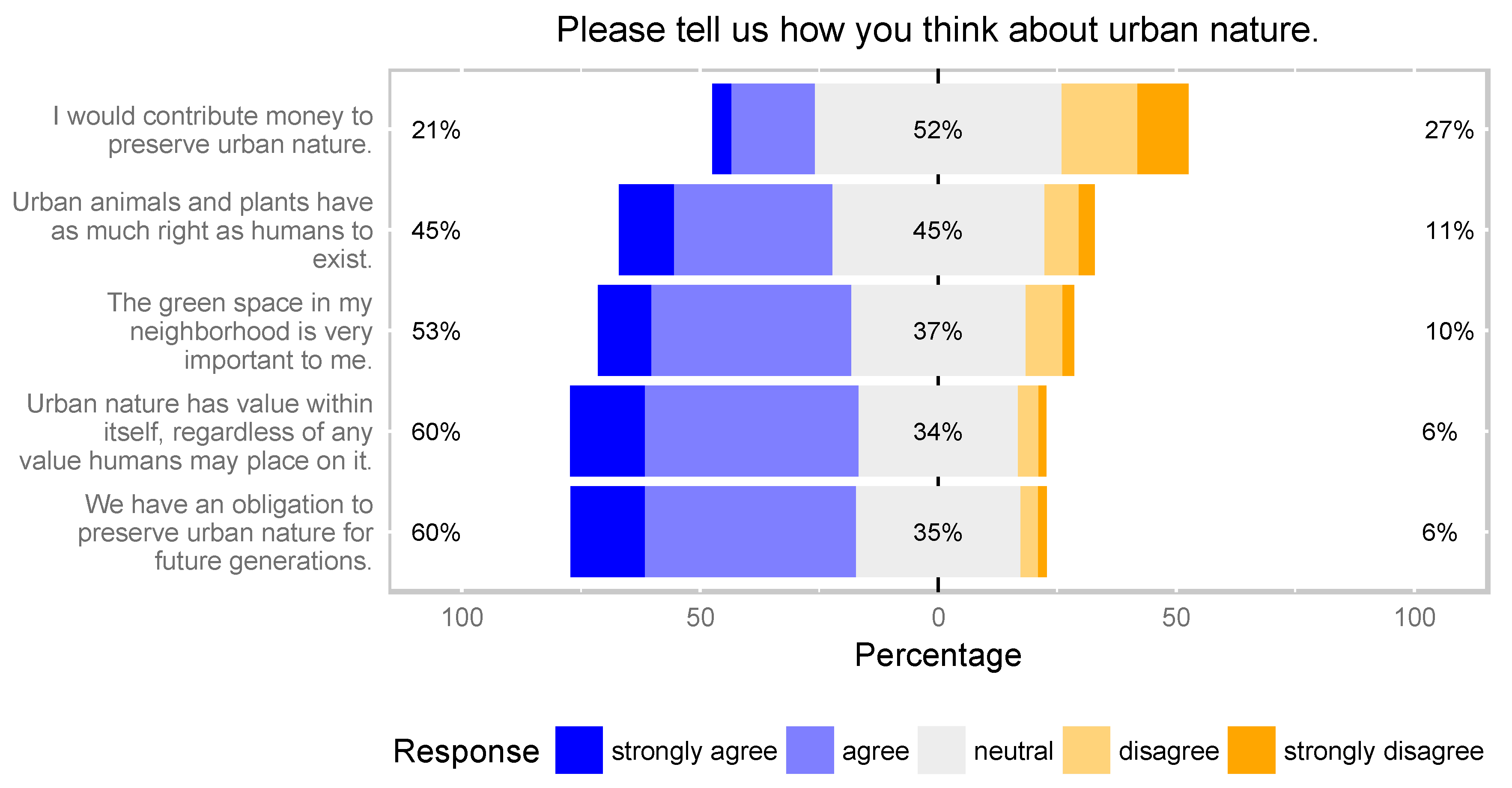
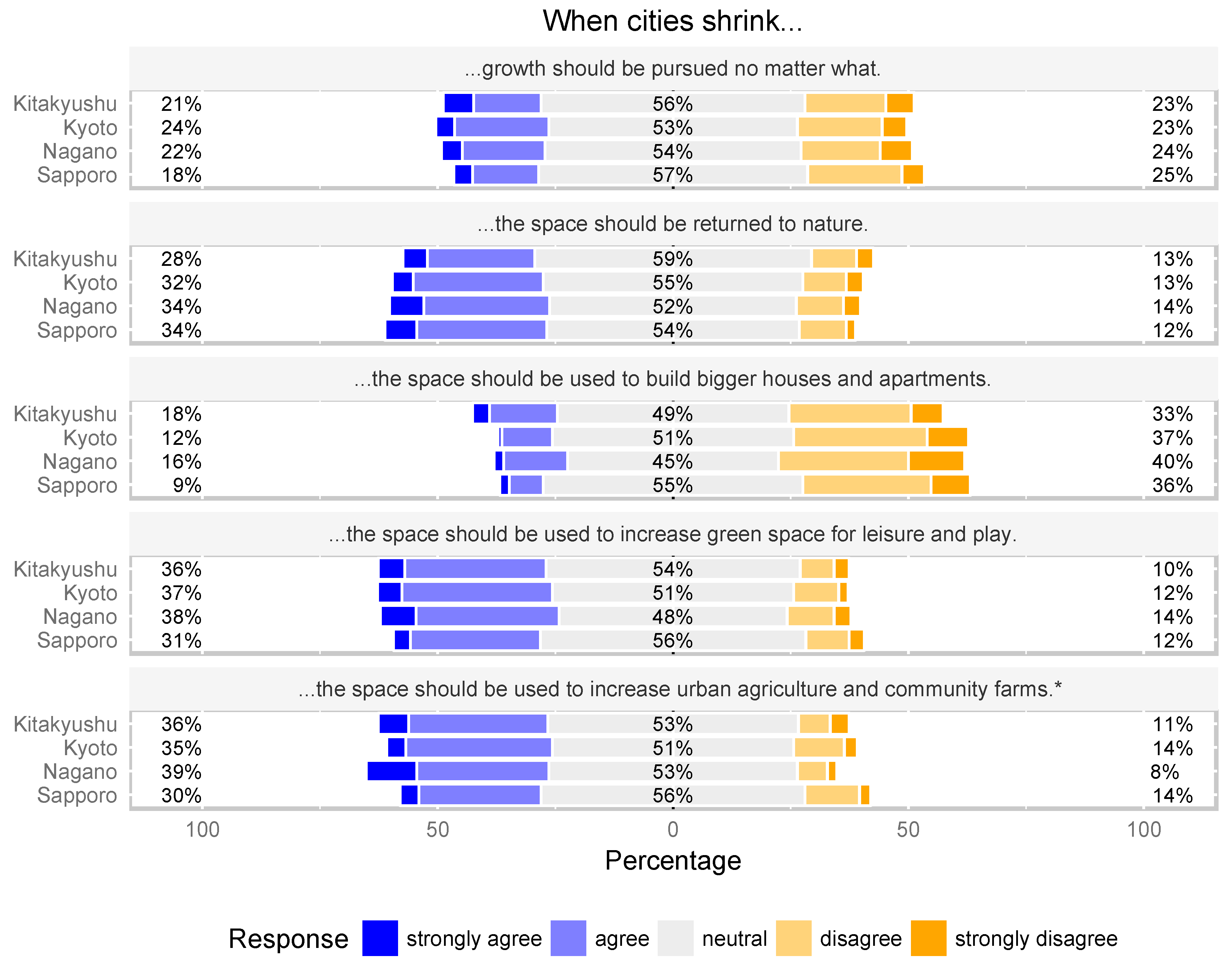
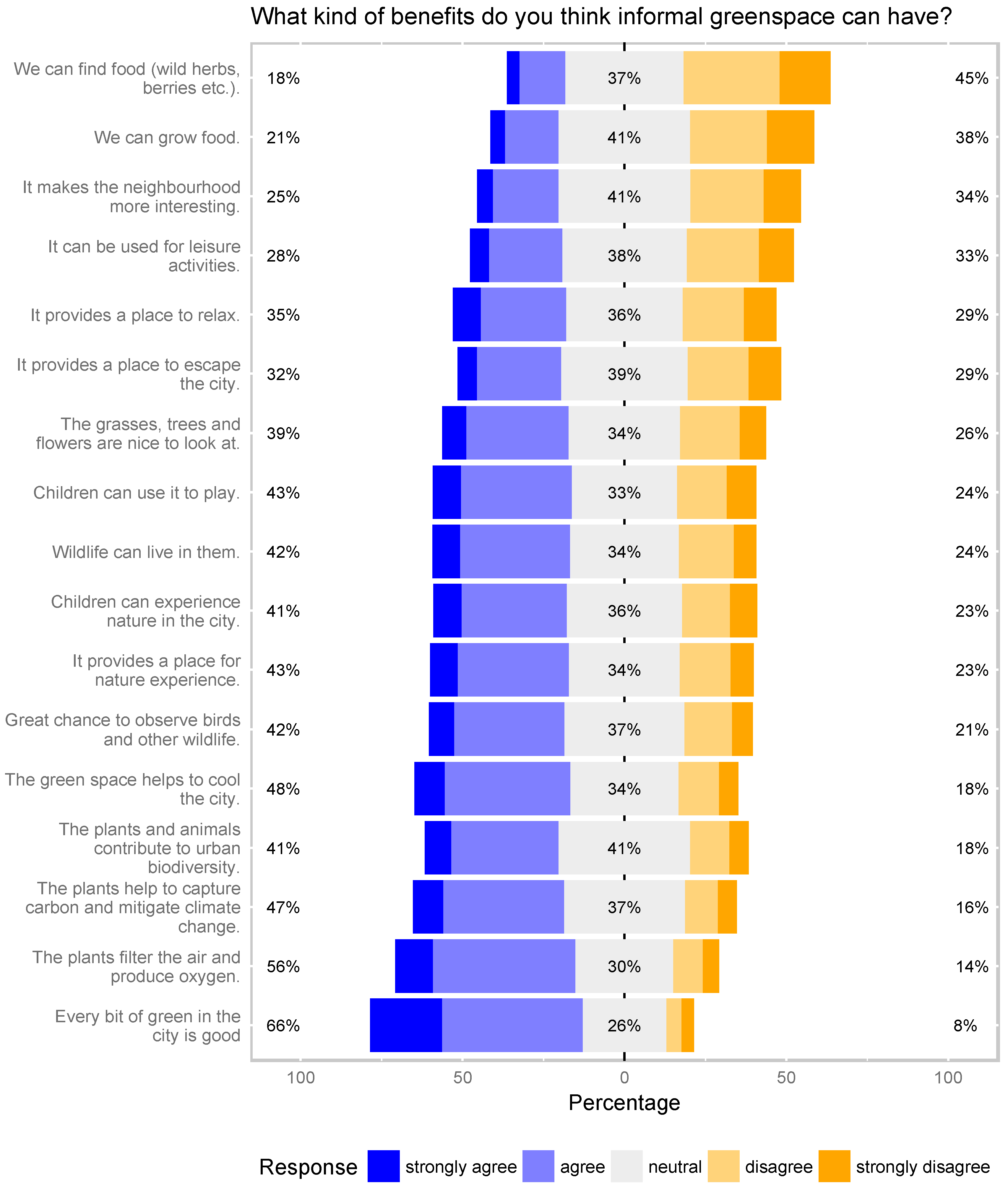
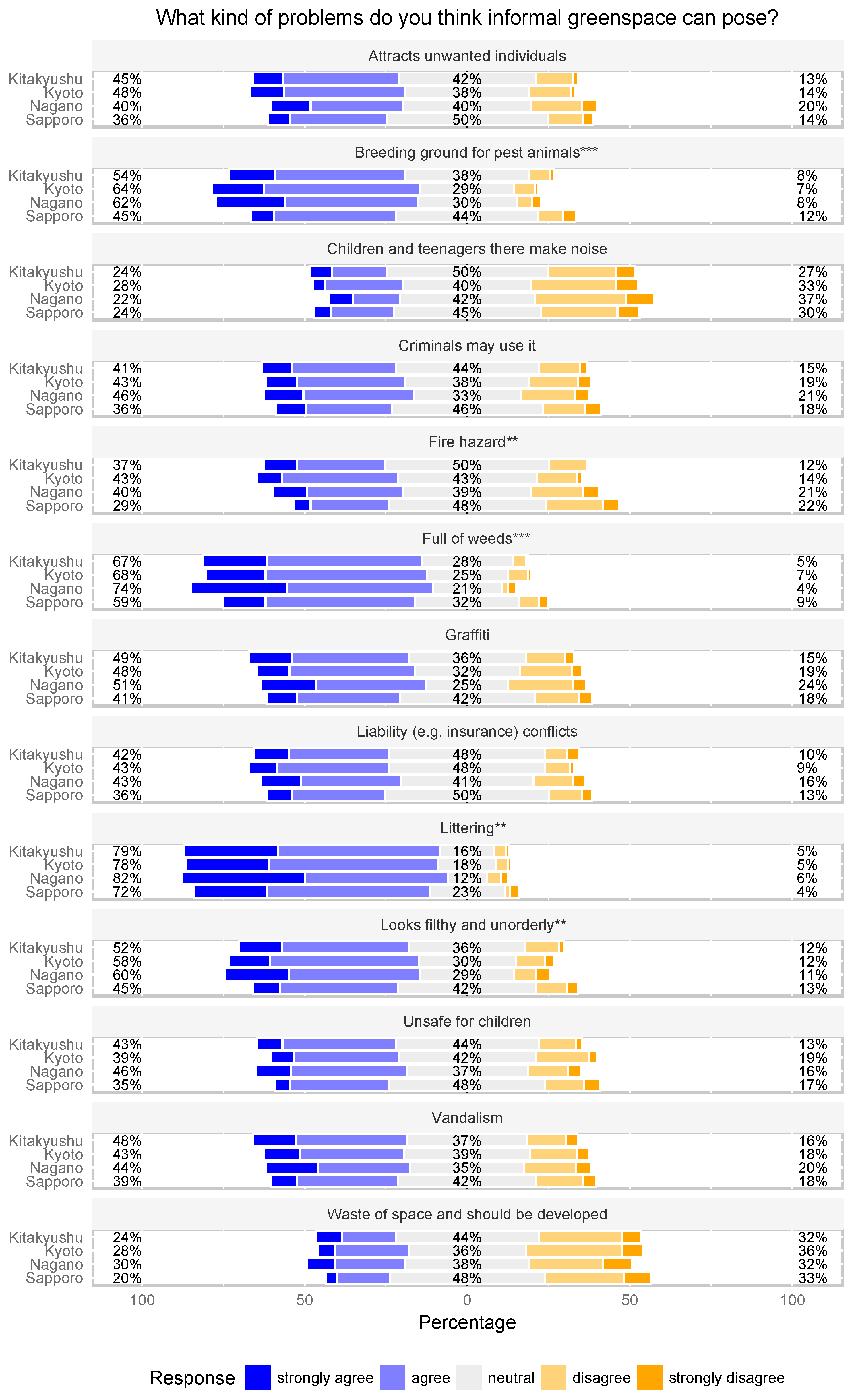
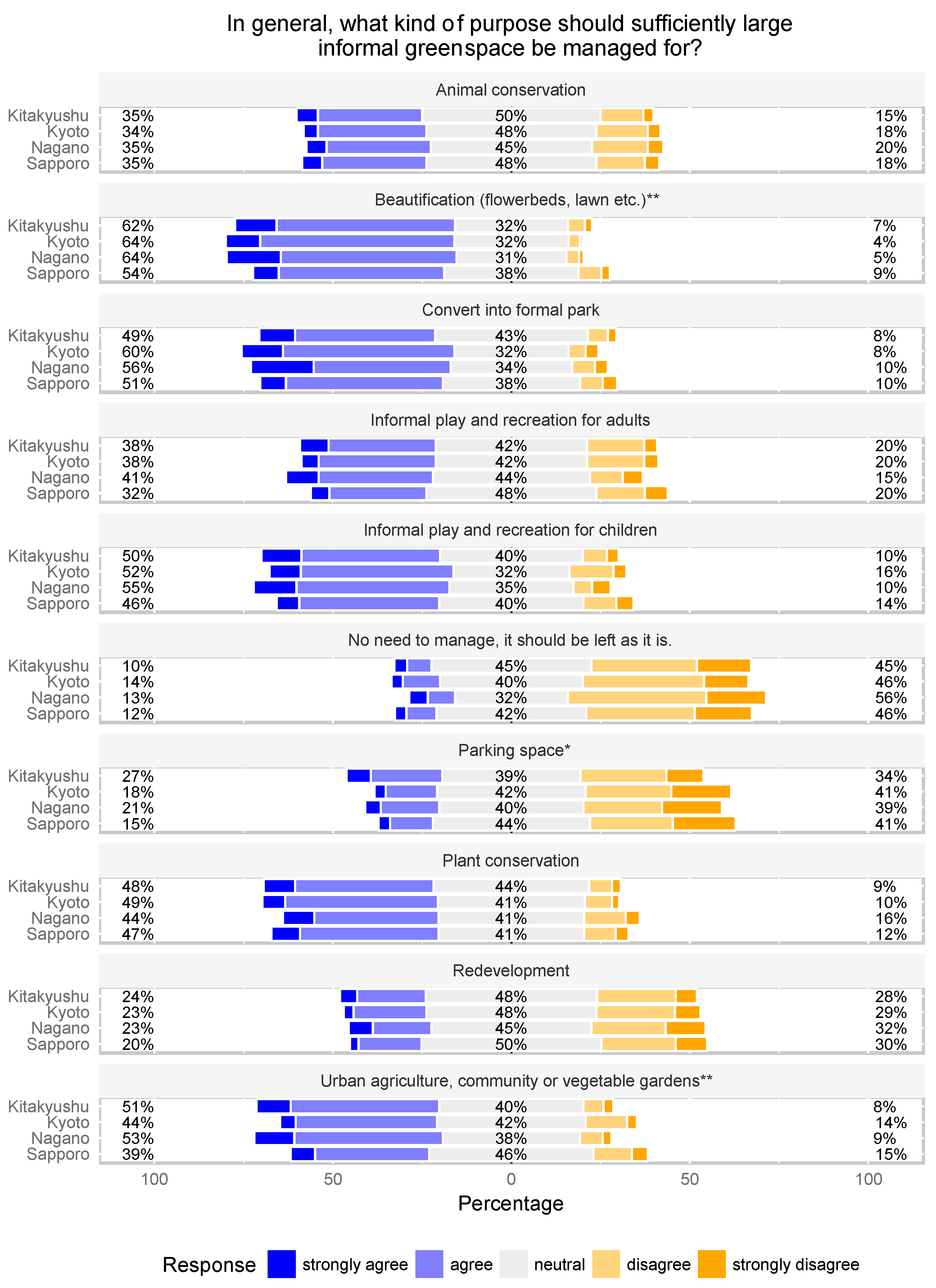
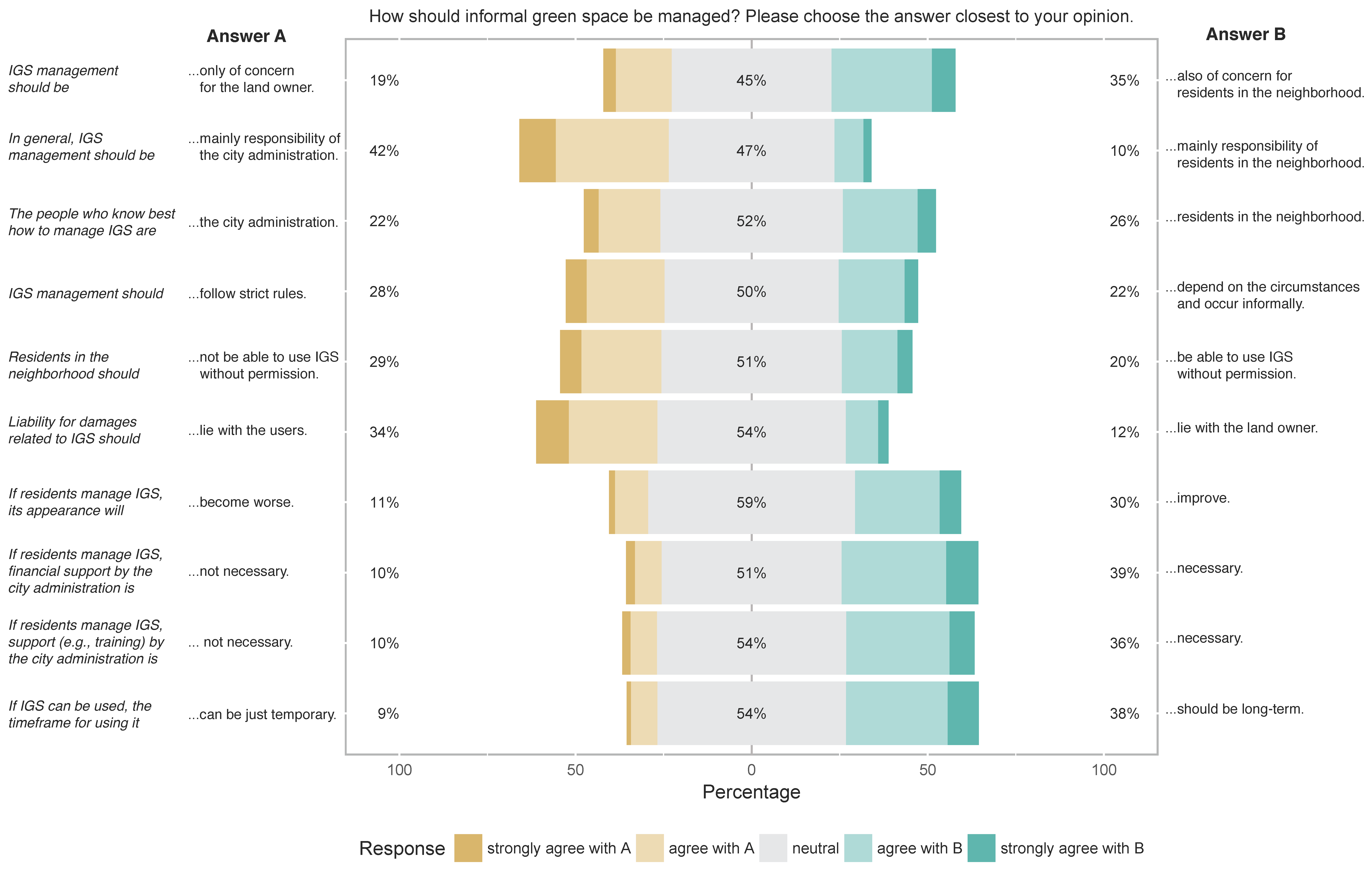
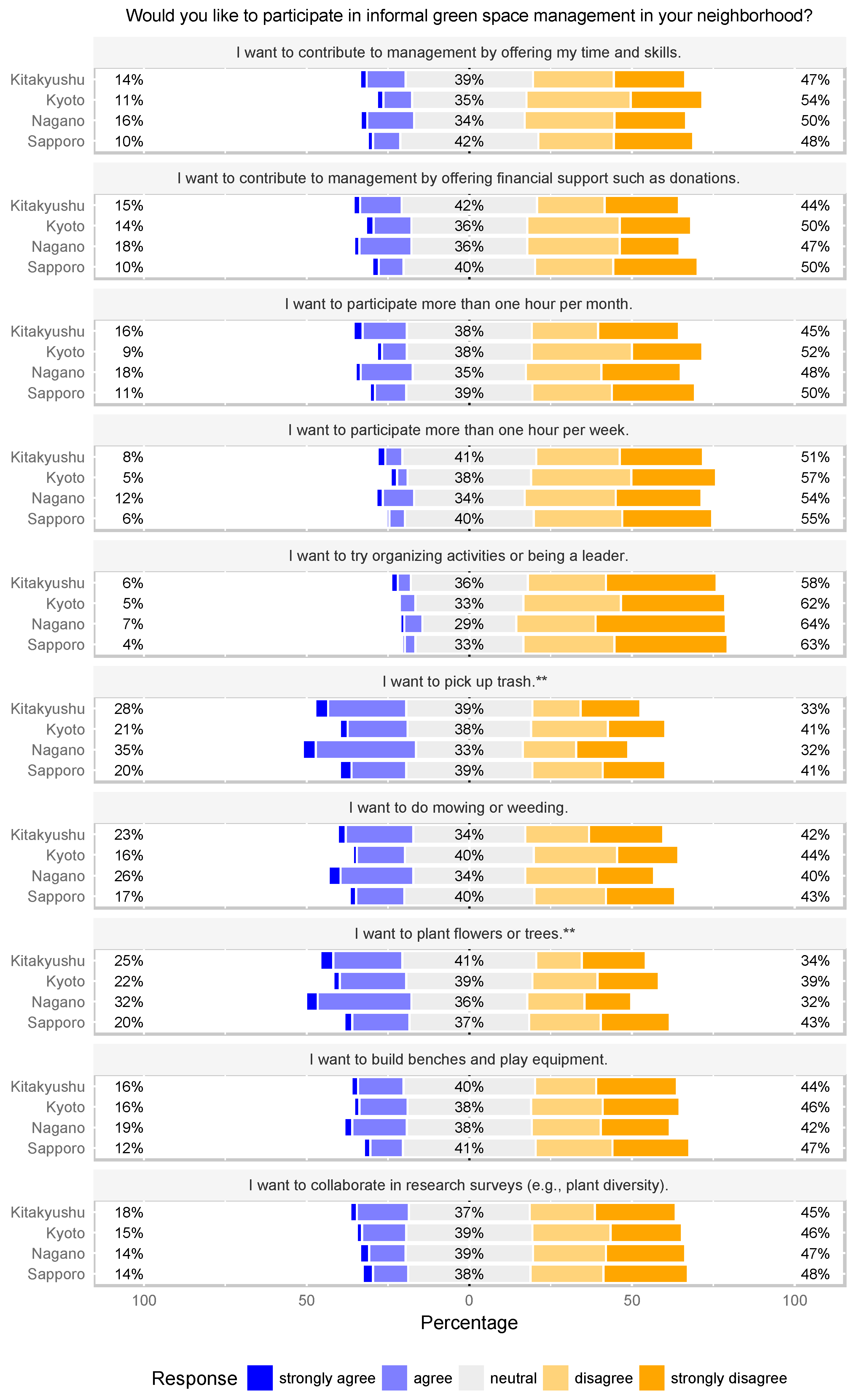
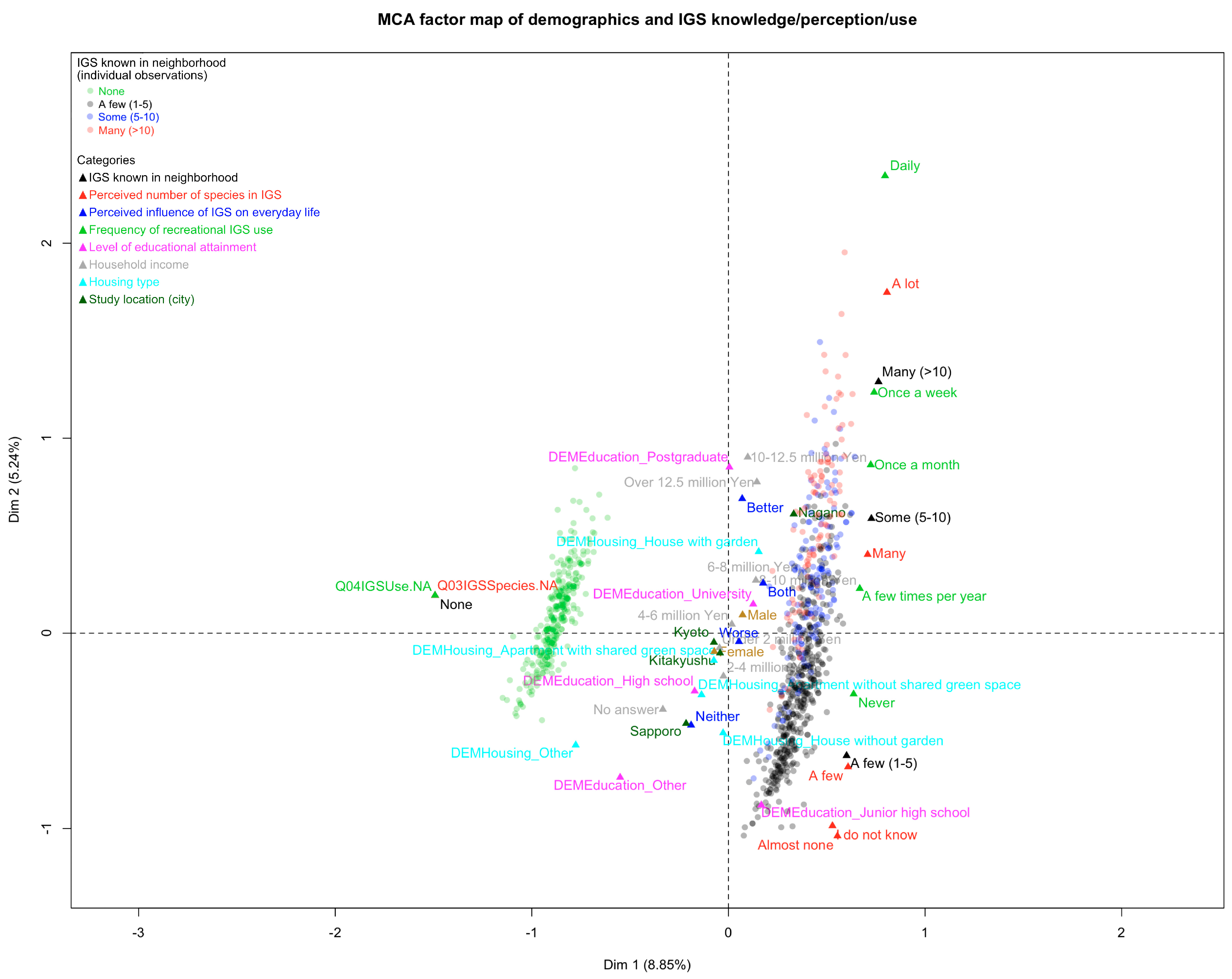

| Characteristics | Sapporo | Kyoto | Kitakyushu | Nagano |
|---|---|---|---|---|
| City status | 1902 (founded 1824) | 1889 (founded ~600 AD) | 1963 (formerly Mojigaseki, founded ~645 AD) | 1897 (founded ~642 AD) |
| Population (2015) | 1.95 million | 1.48 million | 961,000 | 378,000 |
| Projected population (2040) | 1.71 million | 1.28 million | 784,000 | 302,000 |
| Area (km2) | 1121 | 828 | 492 | 835 |
| Population density (inhabitants/km2) | 1741 | 1782 | 1954 | 452 |
| Climate (Köppen-Geiger) | Dfa | Cfa | Cfa | Cfa |
| Green space per capita (2015) | 12.5 | 4.4 | 12.0 | 9.4 |
| Age | Mean/SD/Lowest/Highest | 46/13/20/69 |
| Respondents in their 20s | 16% | |
| Respondents in their 30s | 19% | |
| Respondents in their 40s | 23% | |
| Respondents in their 50s | 20% | |
| Respondents in their 60s | 22% | |
| Sex | Female | 50% |
| Male | 50% | |
| Education (highest attained) | Junior high school | 2% |
| High school | 31% | |
| University | 57% | |
| Postgraduate | 7% | |
| Other | 4% | |
| Housing | Detached with garden | 43% |
| Detached without garden | 10% | |
| Apartment, shared green space | 12% | |
| Apartment, no shared green space | 33% | |
| Other | 1% | |
| Income | Under ¥2 million | 10% |
| ¥2–4 million | 24% | |
| ¥400–600 million | 19% | |
| ¥600–800 million | 13% | |
| ¥800–1000 million | 9% | |
| ¥1000–1250 million | 4% | |
| Over ¥1250 million | 3% | |
| Don’t know/Don’t want to answer | 19% |
| Question Asked | Response Options 1 | Answers (%) |
|---|---|---|
| How many informal green spaces (as introduced above) exist in your neighborhood? (n = 1000) | None | 30.4 |
| A few (1–5) | 44.5 | |
| Some (5–10) | 14.8 | |
| Many (over 10) | 10.3 | |
| What types of informal green spaces do you know of in your neighborhood? Please only select spaces with vegetation other than parks, gardens or plazas. (multiple answers possible; n = 696) | Vacant lots | 73.6 |
| Structures (overgrown walls, fences, roofs etc.) | 34.8 | |
| Railway verges | 29.2 | |
| Street verges | 68.0 | |
| Brownfields | 10.8 | |
| Waterside (river banks, river beds etc.) | 54.7 | |
| Power-line corridors | 15.8 | |
| Gaps (between walls or fences etc.) | 44.8 | |
| How many species of animals and plants do you think live in informal green spaces? (n = 696) | Very few | 4.5 |
| Few | 31.0 | |
| Many | 38.8 | |
| Very many | 9.9 | |
| I don’t know | 15.8 |
| Question Asked | Response Options 1 | Answers (%) |
|---|---|---|
| How often do you use informal green space for recreation, exercise or play etc.? (n = 696) | Never | 78.7 |
| Daily | 0.9 | |
| Once a week | 6.2 | |
| Once a month | 5.0 | |
| A few times per year | 9.2 | |
| Why do you use informal green space and not a park or garden? (n = 148) | It’s near my home | 66.2 |
| It’s wild and exciting | 19.6 | |
| It’s not crowded | 39.2 | |
| There are more or different animals or plants | 19.6 | |
| It has better privacy (nobody watching) | 9.5 | |
| There are no use restrictions (e.g., no dogs, no ball play) | 23.6 | |
| It can be used for many things (e.g., gardening) | 11.5 | |
| There are no nice parks near my home | 12.2 | |
| I don’t have a garden or similar green space | 14.9 | |
| Other | 6.8 | |
| Did you experience any problems when using informal green space? (n = 148) | No | 62.8 |
| Hard to access (fence, signs etc.) | 8.8 | |
| I was scared to use it | 8.8 | |
| Dangerous animals | 5.4 | |
| Dangerous plants | 4.1 | |
| Danger of injury | 10.1 | |
| Lots of litter | 19.6 | |
| Conflict with the owner | 3.4 | |
| Conflict with police | 0.0 | |
| Conflict with other users | 2.7 | |
| Criminals were present | 0.7 | |
| Drug users were present | 0.0 | |
| Prostitutes were present | 0.0 | |
| Other | 2.0 |
© 2017 by the author. Licensee MDPI, Basel, Switzerland. This article is an open access article distributed under the terms and conditions of the Creative Commons Attribution (CC BY) license (http://creativecommons.org/licenses/by/4.0/).
Share and Cite
Rupprecht, C.D.D. Informal Urban Green Space: Residents’ Perception, Use, and Management Preferences across Four Major Japanese Shrinking Cities. Land 2017, 6, 59. https://doi.org/10.3390/land6030059
Rupprecht CDD. Informal Urban Green Space: Residents’ Perception, Use, and Management Preferences across Four Major Japanese Shrinking Cities. Land. 2017; 6(3):59. https://doi.org/10.3390/land6030059
Chicago/Turabian StyleRupprecht, Christoph D. D. 2017. "Informal Urban Green Space: Residents’ Perception, Use, and Management Preferences across Four Major Japanese Shrinking Cities" Land 6, no. 3: 59. https://doi.org/10.3390/land6030059
APA StyleRupprecht, C. D. D. (2017). Informal Urban Green Space: Residents’ Perception, Use, and Management Preferences across Four Major Japanese Shrinking Cities. Land, 6(3), 59. https://doi.org/10.3390/land6030059






